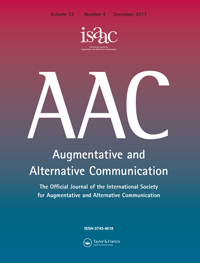| Authors | Simon Judge, Nicky Randall, Janice Murray, Yvonne Lynch, Stuart Meredith, Liz Moulam, Juliet Goldbart, Martine Smith |
|---|---|
| Journal | Augmentative and Alternative Communication, July 2019 |
| DOI | https://doi.org/10.1080/07434618.2019.1597384 |

| Authors | Simon Judge, Nicky Randall, Janice Murray, Yvonne Lynch, Stuart Meredith, Liz Moulam, Juliet Goldbart, Martine Smith |
|---|---|
| Journal | Augmentative and Alternative Communication, July 2019 |
| DOI | https://doi.org/10.1080/07434618.2019.1597384 |

Existing research suggests the provision of communication aids for children with complex communication needs can have significant positive impacts on health and quality-of-life. The process of clinical decision-making related to the recommendation of high-tech communication aids is not well documented or evaluated, and research evidence related to the provision of these aids remains limited.
This study aimed to understand the factors that specialized AAC professionals in the UK consider when recommending high-tech communication aids. Purposive sampling was used to recruit teams to six focus groups, each of which centred on a team’s recent recommendation process (i.e. a discussion following a real-time assessment session, where the team attempted to arrive at an agreed recommendation for a specific child).
Thematic network analysis was used to interpret data from the focus group discussions. Participants identified a wide range of child characteristics, access features, and communication aid attributes in weighing up decisions for individual children.
Findings suggest that specialized AAC professionals in the UK prioritize access features over language considerations in their communication aid recommendations. An explanatory model was developed to illustrate the interaction effect that several competing considerations may have on decision-making. Implications for clinical practice and future research are discussed.